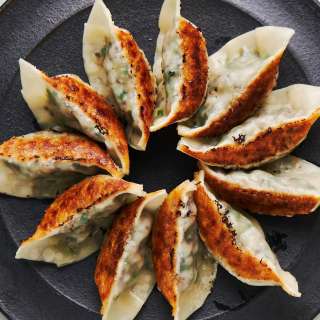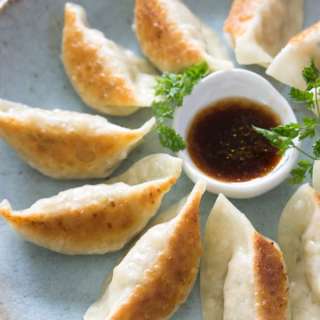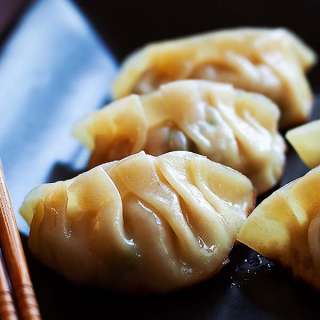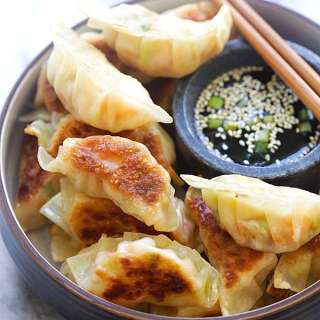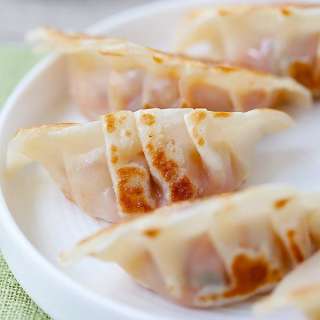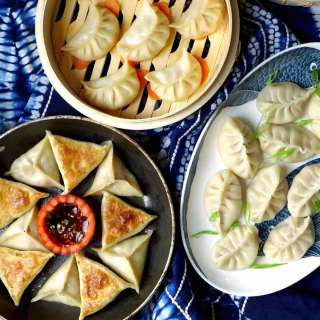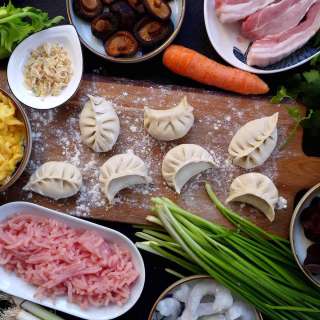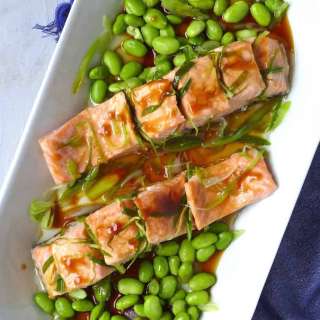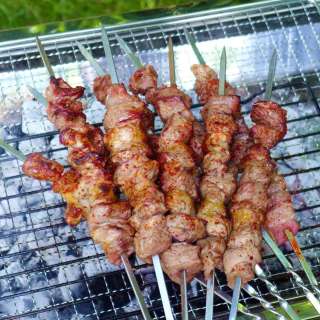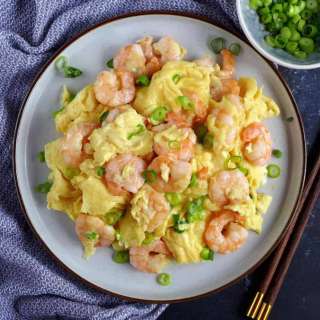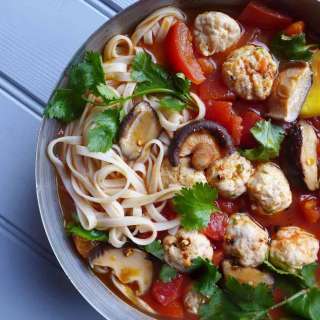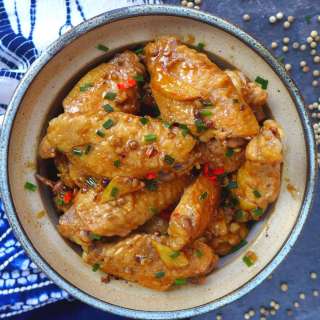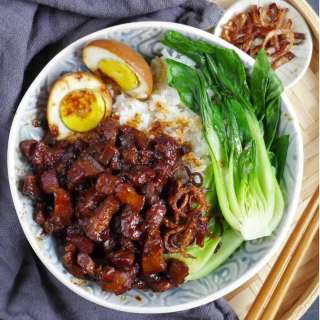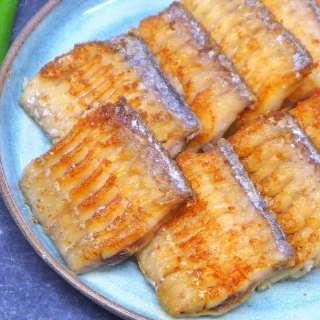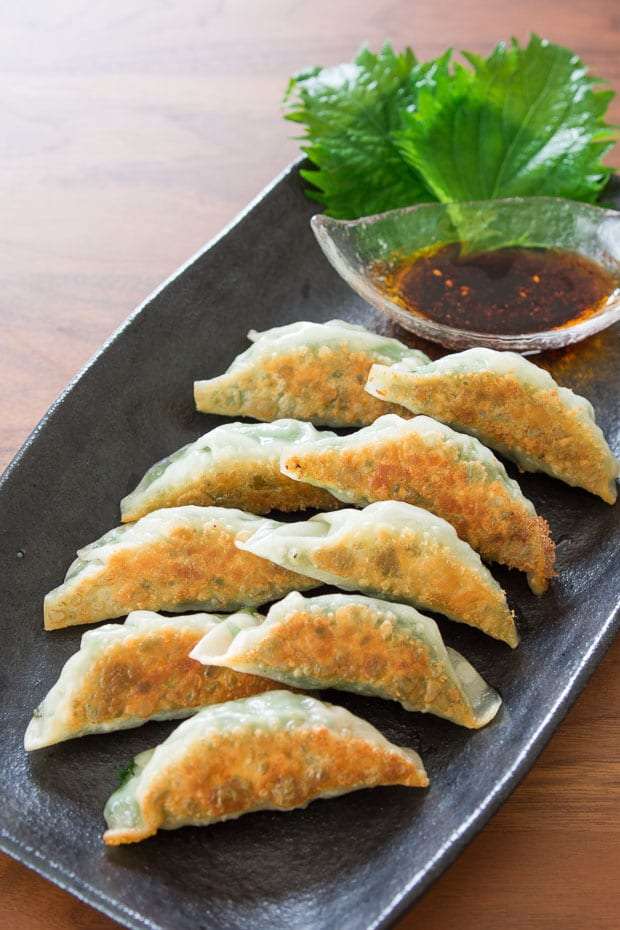
Shiso Gyoza
User Reviews
5.0
6 reviews
Excellent
-
Prep Time
30 mins
-
Cook Time
30 mins
-
Total Time
40 mins
-
Servings
40 dumpling
-
Calories
42 kcal
-
Course
Main Course, Appetizer

Shiso Gyoza
Report
Crisp on the bottom, tender on top, these pork and garlic chive gyoza (餃子) are wrapped with green shiso for a tasty twist on classic Japanese potstickers.
Share:
Ingredients
For Filling
- 200 grams cabbage (¼ small head)
- 200 grams ground pork
- 30 grams scallions (minced)
- 30 grams garlic chives (minced)
- 15 grams fresh ginger (~½-inch length, grated)
- 1 tablespoon Potato Starch
- 1 tablespoons toasted sesame oil
- 1 tablespoons soy sauce
- 1 tablespoon sake
- ½ teaspoon salt
- ¼ teaspoon ground white pepper
For Gyoza
- 40 Gyoza wrappers (a.k.a. potsticker wrappers)
- 40 leaves green shiso (stems trimmed)
- vegetable oil (for frying)
For Sauce
- 2 tablespoons soy sauce
- 2 tablespoons rice vinegar
- Chili oil (optional)
Instructions
- Put the cabbage in a pot and add enough water to cover it. Cover the pot with a lid and bring to a boil. Boil the cabbage until it is starting to wilt (about 2-3 minutes). Drain the cabbage in a colander while you prepare the other ingredients.
- In a bowl, add the ground pork, scallions, garlic chives, ginger, potato starch, sesame oil, soy sauce, sake, salt and white pepper.
- When the cabbage has cooled enough to handle, shake off any excess water that has collected between the leaves, but do not squeeze the leaves (the water content of the cabbage is the secret to juicy gyoza!). Remove the core and discard. Chop the cabbage into ¼-inch pieces and add it in with the pork.
- Put some gloves on and knead the pork and cabbage together until it forms a relatively uniform paste. Gyoza makers in Japan say that gathering up the meat and throwing it back into the bowl makes the filling more tender, but I haven't seen any evidence to support this claim.
- Prepare a bowl of water to wet your fingers with as well as a tray lined with parchment paper to hold your wrapped gyoza.
- To fold the gyoza, put a wrapper in the palm of your left hand (assuming you're right handed).
- Place a shiso leaf in the middle of the wrapper. If your leaves are too large, you may need to trim them down so so they fit in the center of your wrapper without going all the way to the edges.
- Add a little less than a tablespoon of filling into the cent of the leaf.
- Wet the fingers of your right hand and moisten the entire rim of the wrapper like you would an envelope. You need to get enough water onto the rim to make the wrapper stick, but not so much that you make it mushy.
- Fold the wrapper over and then use your thumb and forefinger to pleat the edge from the left to the right.
- As you pleat, use your left thumb to press the completed pleats down to seal the dumpling.
- When you're done, put the dumpling in the palm of your hand and make sure it stands up with the pleats facing up. If it's not stable, tweak the shape a little so that it's able to stand with the pleats facing up.
- Place the dumpling on the prepared tray and repeat until you are out of filling.
- To fry the dumplings, prepare a small bowl with 3 tablespoons of water. Heat 2 tablespoons of oil in a heavy bottomed 10 to 12 inch non-stick pan over medium high heat until hot. Line up the dumplings in rows and let them fry until the bottoms take on just a hint of color. The pan should fit 10-12 dumplings at a time.
- Hold a lid with the side closest to you touching the pan like an open clam shell (the opening should be facing away from you). Reach around and quickly pour in the 3 tablespoons of water and shut the lid as fast as possible. As you might imagine pouring water on to hot oil will result in a lot of spattering. Be careful and quick to avoid making a mess.
- Let the dumplings steam until there is no water left in the pan (this should take about 2 minutes). Because of variations in pots and their lids it's possible you might run out of water more quickly. If this happens, add a bit more water and continue steaming.
- When the water is gone, remove the lid and fry the gyoza until they are golden brown on the bottom.
- Serve the gyoza browned side up so they don't get soggy. For the dipping sauce, just mix equal parts soy sauce and rice vinegar and add some chili oil to taste.
- These gyoza can be frozen on the parchment lined trays. Once they're frozen you can put them in a tupperware or freezer bag. When you cook them, the process is the same, but you will need to use more water and let them steam longer (about 5-6 minutes) to make sure they're cooked through.
Nutrition Information
Show Details
Calories
42kcal
(2%)
Carbohydrates
5g
(2%)
Protein
2g
(4%)
Fat
2g
(3%)
Saturated Fat
1g
(5%)
Cholesterol
4mg
(1%)
Sodium
151mg
(6%)
Potassium
40mg
(1%)
Fiber
1g
(4%)
Sugar
1g
(2%)
Vitamin A
45IU
(1%)
Vitamin C
2mg
(2%)
Calcium
7mg
(1%)
Iron
1mg
(6%)
Nutrition Facts
Serving: 40dumpling
Amount Per Serving
Calories 42 kcal
% Daily Value*
| Calories | 42kcal | 2% |
| Carbohydrates | 5g | 2% |
| Protein | 2g | 4% |
| Fat | 2g | 3% |
| Saturated Fat | 1g | 5% |
| Cholesterol | 4mg | 1% |
| Sodium | 151mg | 6% |
| Potassium | 40mg | 1% |
| Fiber | 1g | 4% |
| Sugar | 1g | 2% |
| Vitamin A | 45IU | 1% |
| Vitamin C | 2mg | 2% |
| Calcium | 7mg | 1% |
| Iron | 1mg | 6% |
* Percent Daily Values are based on a 2,000 calorie diet.
Genuine Reviews
User Reviews
Overall Rating
5.0
6 reviews
Excellent
Other Recipes
